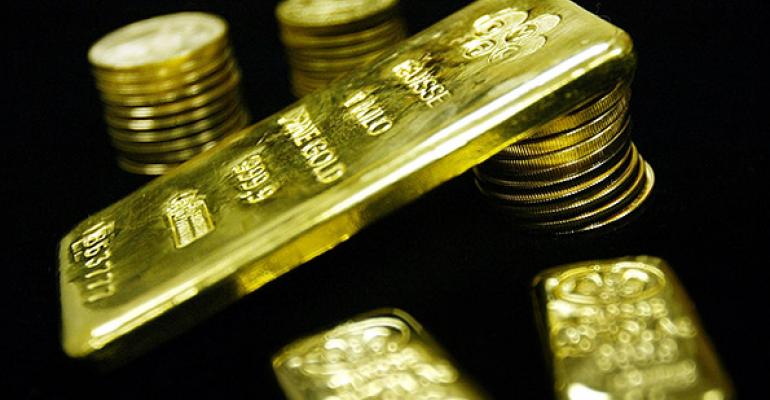(Bloomberg) -- Investors judging the world economic outlook as a bit more stable are taking some of the shine off gold.
Hedge funds and other speculators cut their wagers on a rally for the metal for the first time in six weeks, scaling back from an all-time high position in the prior week. Holdings in exchange-traded funds backed by bullion posted the first weekly loss since the end of May as prices in New York did the same.
The interest in gold has dissipated after the metal zoomed to a two-year high earlier this month amid concerns that the U.K.’s decision to leave the European Union would spark malaise for the global economy. Since then, the tumult over the Brexit vote has died down as policy makers signal they will take steps to limit the fallout. The U.S. economy has stayed strong and investors have pushed the S&P 500 Index of equities to all-time highs, curbing the need for precious metals as a refuge.
“Gold can take a step back and not have to perform the particular role as a safe haven,” said Frances Hudson, an Edinburgh-based global thematic strategist at Standard Life Investments, which oversees $373.3 billion. “Maybe equities are coming from a long way back and this is a chance for a rally, at least in the short term. That keeps gold in reserve, because the world isn’t falling off a cliff immediately.”
Wagers Drop
The net-long position in gold futures and options fell 5.4 percent to 271,529 contracts in the week ended July 12, according to Commodity Futures Trading Commission data released three days later. A week earlier, the holdings were 286,921, the highest in data going back to 2006.
Futures traded in New York dropped 2.3 percent last week to $1,327.40 an ounce, snapping six straight gains. The metal has lost 3.6 percent since reaching the highest in more than two years on July 6. The rally ran out of steam as global central bankers, including in England and Japan, said they will take steps to limit the economic impact from the U.K.’s June 23 vote to leave the EU.
At the same time, gains for U.S. retail sales and industrial production are reflecting the resilience of the American economy and driving gains for the dollar. The outlook for growth also prompted traders to boost the chances of a U.S. interest-rate increase by December to 44 percent, up from 12 percent at the start of the month. Higher rates reduce the appeal of gold, which doesn’t pay interest or offer dividends like assets such as bonds or equities.
Global holdings in bullion ETPs dropped by 5.3 metric tons last week to 2,001 tons, data compiled by Bloomberg show. That was the biggest decline since April 22. Metal held in the No. 1 product, SPDR Gold Shares, tumbled by 1.9 percent, the most since early December.
Trend Reversal
The negative sentiment for gold is a reversal from the adoration investors have felt for most of the year. Funds have been betting on price gains since they turned net-long on the metal in January, and the position surged 84 percent in the five weeks through July 5, CFTC data show. Prices are still up 25 percent this year in New York. Silver, which often has outsized moves among precious metals, has jumped 46 percent, the most among the 22 components of the Bloomberg Commodity Index.
While hedge funds are taking a break from the metal, U.S. retail investors are still betting that geopolitical risks mean bullion’s luster hasn’t yet dulled. Through last week, U.S. Mint sales of gold coins in 2016 totaled more than 500,000 ounces, double the amount sold at this time a year earlier. The metal rose in after-hours trading in New York on Friday amid a coup attempt against Turkish President Recep Tayyip Erdogan.
The U.S. election cycle could also stoke price gains as the “political debate heats up,” Francisco Blanch, the head of commodities research at Bank of America Merrill Lynch, said in an interview with Bloomberg Television Canada last week. Prices could reach $1,500 in the next six to 12 months, he said, also citing the prospect of low long-term interest rates.
“The retail side of this trade could continue, which would be the positive for gold,” said Rob Haworth, a senior investment strategist in Seattle at U.S. Bank Wealth Management, which oversees $133 billion. “If I look year-end towards other factors, even as you unwind safe-haven trades, stocks are up and everyone is feeling good. You’ll probably see a bias towards dollar strength for the rest of the year, and that doesn’t benefit gold.”
To contact the reporter on this story: Joe Deaux in New York at [email protected] To contact the editors responsible for this story: James Attwood at [email protected] Millie Munshi, Steven Frank





